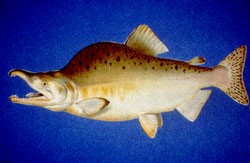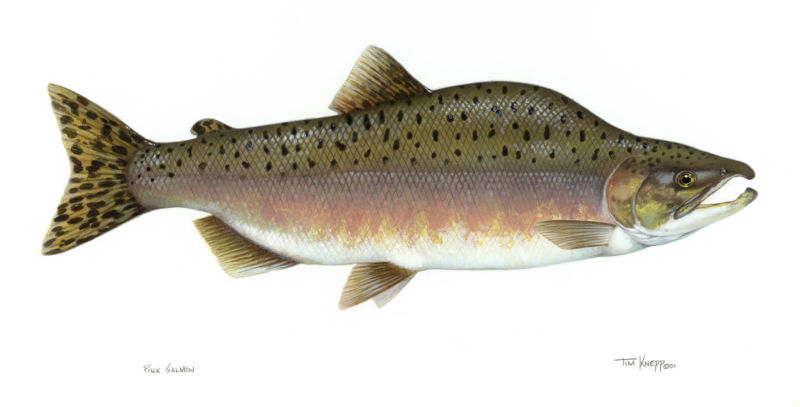|
PINK SALMONLove Cold Waters
World Record: 13lbs 1ozPink Salmon Taxonomy Kingdom: Animalia Phylum: Chordata Class: Actinopterygii Order: Salmoniformes Family: Salmonidae Genus: Oncorhynchus
Oncorhynchus gorbuscha is the garble that science lovers know them as. We call them dinner! Males are commonly known as “humpies”. Read on to see why, because there will be a pop quiz later.
Where to find them and their Life cycle.
This one likes the cold water, too. Waters of 10 degrees Fahrenheit are preferred. When water temps go above 25 degrees, it is deadly to the "Pink." They are native to the salt water of the Pacific from Northern California (Sacramento River) to Canada’s Mackenzie River. Further west, they are plentiful from Siberia to Korea. This species is even known in Asia, and has a presence around Hondo Island in Japan. The Pink Salmon’s name is a little misleading. That’s because it’s not pink in color. Actually, the fish are bright silver when in the sea. During spawning, they turn a dull grey with a yellowish belly, white mouth and black gums. Big black oval spots adorn the back and tail, leading to some confusion with the spotted trout at times. Spawning season is between June and October. The mature females dig a nest, called a red, with swishes of the tail along the gravelly bottom. Each nest can contain up to 2000 eggs in “clutches” of several hundred eggs each. As she is laying the eggs, as many as 4 males will come to her and fertilize them. The male develops a huge “Quasimodo” type hump on the back during spawning, thus the nickname "humpies”. The female will guard the nests until she dies naturally. These salmon are destined to perish like this, so any of them you can catch are less than two years old.
What they eat and when.
Like many of the salmon family of tasty aquatic treats, the Pink is an opportunity feeder. While in the ocean, they will eat plankton, small crustaceans (shrimp, crabs, etc…). The dietary content changes very little during spawning when insects and terrestrial floaters fill in the blanks. Their carnivorous cousins (Coho and sockeye salmon) smack their lips on smaller fish. So I guess the Pink is a bit less of a bully in salmon terms. How we eat them and how to cook 'em.
Salmon can be prepared several different ways. Smoking is a popular method used by anglers. Since the Pink Salmon is smaller in size, sautéing, baking, poaching and/or broiling/grilling all work well. The flesh of the Pink is firmer than other salmon, yet not quite the delicacy that trout can be. Our guy has it’s own distinct taste characteristics.
Species like Pink Salmon and the differences.
Because of the coloration of the Pink Salmon, it has been confused with spotted trout or ocean going rainbow trout. True that it has characteristics of both, the difference is the color of the fish. True Pinks are bright silver and have a white mouth with black gums. Neither the rainbow nor the spotted trout has these features. Then there is the size difference. Pinks only grow to about 5 pounds, where rainbows or spotted trout will be somewhat larger as adults. For further information, please CONTACT US or visit our ONLINE FLY SHOP.
Return from Pink Salmon to Fish Species
|



